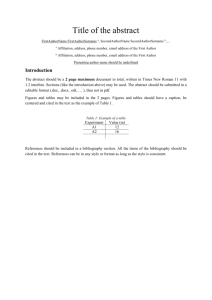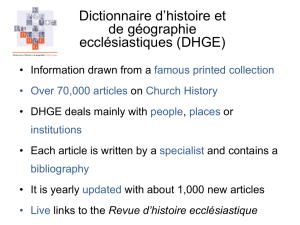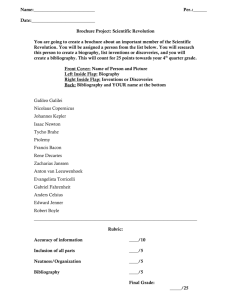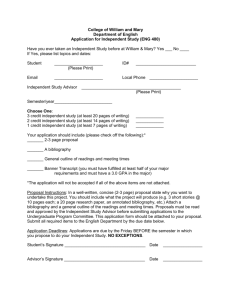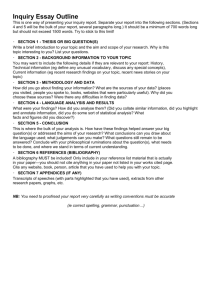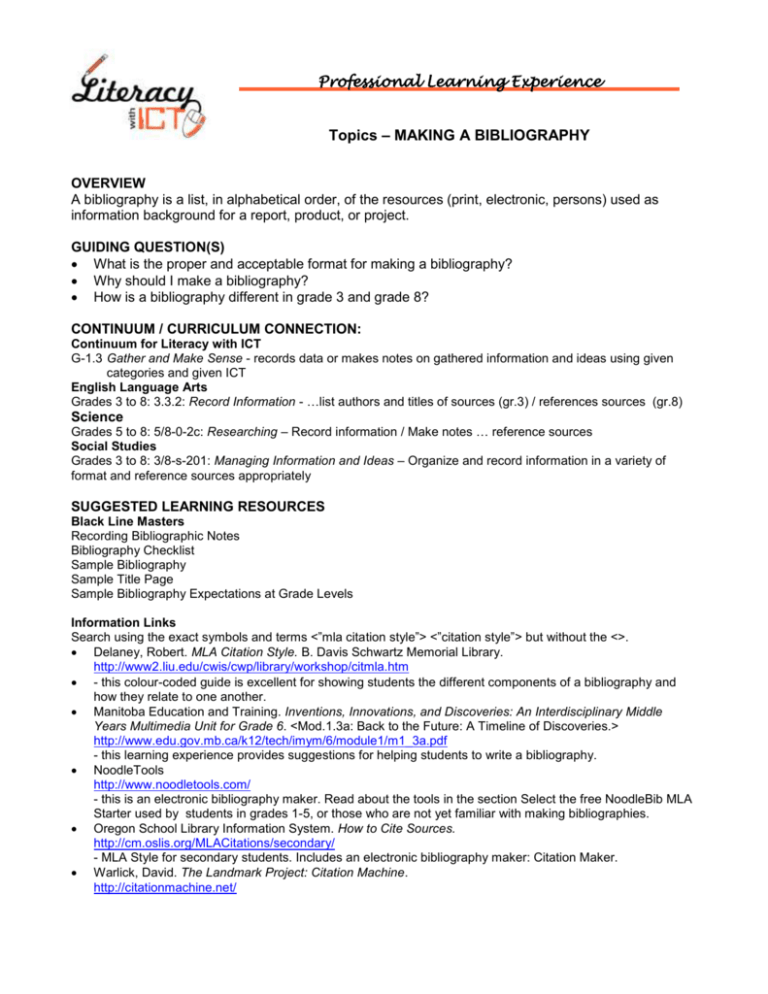
Professional Learning Experience
Topics – MAKING A BIBLIOGRAPHY
OVERVIEW
A bibliography is a list, in alphabetical order, of the resources (print, electronic, persons) used as
information background for a report, product, or project.
GUIDING QUESTION(S)
What is the proper and acceptable format for making a bibliography?
Why should I make a bibliography?
How is a bibliography different in grade 3 and grade 8?
CONTINUUM / CURRICULUM CONNECTION:
Continuum for Literacy with ICT
G-1.3 Gather and Make Sense - records data or makes notes on gathered information and ideas using given
categories and given ICT
English Language Arts
Grades 3 to 8: 3.3.2: Record Information - …list authors and titles of sources (gr.3) / references sources (gr.8)
Science
Grades 5 to 8: 5/8-0-2c: Researching – Record information / Make notes … reference sources
Social Studies
Grades 3 to 8: 3/8-s-201: Managing Information and Ideas – Organize and record information in a variety of
format and reference sources appropriately
SUGGESTED LEARNING RESOURCES
Black Line Masters
Recording Bibliographic Notes
Bibliography Checklist
Sample Bibliography
Sample Title Page
Sample Bibliography Expectations at Grade Levels
Information Links
Search using the exact symbols and terms <”mla citation style”> <”citation style”> but without the <>.
Delaney, Robert. MLA Citation Style. B. Davis Schwartz Memorial Library.
http://www2.liu.edu/cwis/cwp/library/workshop/citmla.htm
- this colour-coded guide is excellent for showing students the different components of a bibliography and
how they relate to one another.
Manitoba Education and Training. Inventions, Innovations, and Discoveries: An Interdisciplinary Middle
Years Multimedia Unit for Grade 6. <Mod.1.3a: Back to the Future: A Timeline of Discoveries.>
http://www.edu.gov.mb.ca/k12/tech/imym/6/module1/m1_3a.pdf
- this learning experience provides suggestions for helping students to write a bibliography.
NoodleTools
http://www.noodletools.com/
- this is an electronic bibliography maker. Read about the tools in the section Select the free NoodleBib MLA
Starter used by students in grades 1-5, or those who are not yet familiar with making bibliographies.
Oregon School Library Information System. How to Cite Sources.
http://cm.oslis.org/MLACitations/secondary/
- MLA Style for secondary students. Includes an electronic bibliography maker: Citation Maker.
Warlick, David. The Landmark Project: Citation Machine.
http://citationmachine.net/
- this is an electronic bibliography maker; select the style you need and enter the information. Citation
Machine will create your bibliography in correct format.
See also: related Professional Learning for Teachers
Topics – PLAGIARISM
Topics – NOTEMAKING
SUGGESTIONS FOR LEARNING
Activating My Prior Knowledge:
Answer the following questions:
o When was the last time I made a bibliography?
o Did I notice that not all formats look the same?
o What information do I need to include in a bibliography?
o Which resources other than books do I include?
Acquiring Information:
Finding out the basic information about making a bibliography
o What are the parts of a book and where do we find information?
o The title page contains more information than the cover, which is why it is used as a source.
For students, it is also easier to find information set up in a clear manner as the cover can
often be set up in a fanciful way.
o The most challenging part could be identifying the appropriate information to be included in a
bibliography. How to insure it is correct? (See BLM – Sample Title Page and Delaney’s
website)
Learning more about making a bibliography
o Make a bibliography “by hand” following the MLA style as explained and illustrated by Denaley.
Use an electronic bibliography maker such as NoodleTools to create the same citation you
made “by hand”. Compare the two. How did you do? What skills do you need to practice?
o Try the electronic bibliography makers. Practice using them and select one you feel your
students can easily use.
Applying in My Classroom:
What does making a bibliography look like in my classroom?
o In grades Kindergarten, one, and two, ask students to show you the resources they have used
for a project. Ask them to show you where to find the title. While modelling appropriate
behaviour to the whole class, make a simple bibliography with the author and the title of books
used.
o Every time students use resources that should be recorded, spend time to show them how to
do it. There is a specific format for each kind of resource. (BLM – Sample Bibliography)
o Starting in grade 3, students are expected to state the name of the author and the title of a
book used in a project. Specific learning outcome 3.3.2 in English Language Arts states the
specific expectations for each grade. Expect proper format, including punctuation. This will lay
a foundation for proper form for a bibliography as other components get added on in later
years.
o At the beginning of the school year, review the bibliographical format with students. If a new
component (such as publisher or date) is added that was not used in previous years, teach
students about it.
NOTE: Ideally, each school should use a school-wide model for a bibliography, with gradespecific expectations based on the ELA curriculum, so later years teachers can build on skills
they know have been previously acquired by students.
How do I get my students involved in making a bibliography?
o Starting in Kindergarten, use opportunities such as story time to state the title of a book and
name its author so students become familiar with components of a bibliography. Use a style
such as: “Our story today is Love You Forever, written by Robert Munsch, illustrated by Sheila
McGraw”. Show the students where you find the information you just stated on the title page
(not the cover page). Name the parts of a book casually (cover, spine, title page) and
occasionally ask students what to call XXX (as you point to a part of a book)
o For older students, make including a bibliography a part of a project. Include an assessment
component to it.
o The more often you give students an opportunity to cite even one resource, the more
competent at it they will become and making a bibliography will become naturally integrated in
the learning process over time.
What resources can be used to make bibliographies?
o Start with a template to record the information for each resource used. Students keep this with
their project materials. (BLM – Recording Bibliographic Information)
o Once they understand the process of making a bibliography, you may want students to use an
electronic bibliography maker. (See suggested links listed earlier)
Note: An electronic Bibliography maker will only be as good as the accuracy of the information
entered into it.
o Students use BLM – Bibliography Checklist to ensure their bibliography is complete before
submitting it.
Implementation Links
Kelly, Ruth. Memorial School’ Library / Media Center. Who Am I? Do You Know the Parts of a Book?
http://mset.rst2.edu/portfolios/k/kelly_r/FinalWeb/ReadingCtr/BookParts/Game1.html
- online play-questionnaire for Early Years students on basic parts of a book.
SUGGESTIONS FOR ASSESSMENT
Personal Journaling:
o What have I learned that I was not previously aware of?
o What has been clarified?
o What do I want to pursue to find out more?
o Is there any issue I feel I should share with my colleagues? How to I plan to do that?
Providing Feedback:
o Please share with the Literacy with ICT project team, any issue that was not clear, any
questions you have, or suggestions for a future update.
Observing Students:
o What components of a bibliography do students struggle with? Consider spending more time
on this issue.
o Note which students have acquired the habit of recording bibliographic notes without being
asked. Note this on their profile.
BLM - Recording Bibliographic Notes
Name
Date
Book
1. Author(s)
(Found on title page, not on cover.)
Title
(Found on title page.)
Place of Publication
(City and province/state found on title page or back of title page. Take first one if there is more than one.)
Publishing Company
(Usually found on title page.)
Date of Publication
(Found on title page or back of title page. Look for copyright © symbol. Use the most recent date.)
2. Author(s)
Title
Place of Publication
Publishing Company
Date of Publication
3. Author(s)
Title
Place of Publication
Publishing Company
Date of Publication
4. Author(s)
Title
Place of Publication
Publishing Company
Date of Publication
Personal Interview
Name of Interviewee
Type of Interview (e.g., telephone, personal, letter)
Subject of Interview
Date of Interview
(continued)
BLM - Recording Bibliographic Notes (cont’d)
Newspapers or Magazines
Author(s)
Title of article
Name of Newspaper or Magazine
Date
Page Number
Encyclopedia
Author(s)
(Usually found at end of article, if there is one.)
Title of Article
(e.g., Bears; Saturn; Columbus, Christopher; Second World War)
Name of Encyclopedia
Place of Publication
Publishing Company
Date of Publication
Personal Email
Name of Sender
Date of Email
Subject of Email
Website (this is a student-adapted version)
1. Author(s)
(Could be found on the home page for the site.)
Title of Article
(Usually at top of page.)
Name of Website Host
(e.g., university, company, foundation, museum, school)
Date
Date of Visit
(Date website was first made, or updated.)
(Date information was found on the site for a project.)
URL
2. Author(s)
Title of Article
Name of Website Host
Date
URL
Date of Visit
BLM - Bibliography Checklist
Name
Date
Check whether the bibliographic information below is correct for each entry.
Bibliography Checklist
Student
1. Alphabetical order by author’s last
name
2. All data present:
author(s)
title
place of publication
publisher
date of publication
Student Questions
Teacher Comments
Teacher
BLM - Sample Bibliography
Suggestions
Students can set up a spreadsheet to record bibliographic information. The spreadsheet can be
alphabetized electronically to facilitate creating the bibliography.
Many bibliographic formats are recognized and used widely to document research. The Modern
Language Association (MLA) style is a commonly used style. Consider the following categories.
Book
Gregory, Kathleen, Caren Cameron, and Anne Davies. Setting and Using Criteria: For Use in
Middle and Secondary School Classrooms. Merville, BC: Connections Publishing, 1997.
Newspaper Article
Smith, Jane. “Worst Snow Storm Ever: Schools Closed for Two Weeks.” Manitoba Tribune
12 Feb. 1992: B1.
Magazine Article
Johnson, Mary. “Students in the Kitchen.” Elementary 15.2 (Sept. 2002): 34-39.
Encyclopedia Article
Macdonald, John. “Fiction and the Great North.” The Encyclopedia for Students. 1999.
Interview
Mercredi, Ovide. Telephone interview. 20 Jan. 2001.
Personal Email
Doer, Gary. “Being a Premier.” Email by the author. 30 Sept. 2002.
Website
Boys, Penny. “The Official Rube Goldberg Web Site.” 2001. Rube Goldberg Inc.
<http://www.rube-goldberg.com/>. 25 Oct. 2004.
NOTE: When handwriting a bibliography, the title of the resource is underlined (but is italicized in an
electronic format).
You may make or ask a student to make a poster of this format and put it up on the wall in your
classroom.
BLM – Sample Bibliography Expectations at Grade Levels
English Language Arts
3.3.2: Record Information Grade 3
record facts and ideas using a variety of strategies [such as outlining, webbing, charting…]; list authors and
titles of sources
Grade 4
make notes of key words, phrases, and images by subtopics; cite authors and titles of sources alphabetically
Grade 5
record information in own words; cite authors and titles alphabetically and provide publication dates of sources
Grade 6
make notes on a topic, combining information from more than one source; reference sources appropriately
Grade 7
make notes using headings and subheadings or graphic organizers appropriate to a topic; reference sources
Grade 8
make notes in point form, summarizing major ideas and supporting details; reference sources
Grades K-1-2
While students are not expected to write a bibliography, they should be able to tell the name of the
author and the title of a book they used for a project.
The classroom teacher should always note sources in a whole class project.
Grade 3 Sample Bibliography
Bannatyne-Cugnet, Jo. From Far and Wide.
Moore, Christopher. The Big Book of Canada.
Berenstain, Stan. The Berenstain Bears Don't Pollute (Anymore).
Grade 4 Sample Bibliography
Bannatyne-Cugnet, Jo. From Far and Wide.
Berenstain, Stan. The Berenstain Bears Don't Pollute (Anymore).
Moore, Christopher. The Big Book of Canada.
Pegis, Jessica. All about Canadian Citizenship.
Grade 5 Sample Bibliography
Bannatyne-Cugnet, Jo. From Far and Wide. 2000.
Berenstain, Stan. The Berenstain Bears Don't Pollute (Anymore). 1991.
Moore, Christopher. The Big Book of Canada. 2002.
Pegis, Jessica. All about Canadian Citizenship. 2004.
BLM – Sample Bibliography Expectations at Grade Levels (cont’d)
Grade 6 and Beyond Sample Bibliography
Bannatyne-Cugnet, Jo. From Far and Wide: a Canadian Citizenship Scrapbook. Toronto, ON:
Tundra Books, 2000.
Berenstain, Stan. The Berenstain Bears Don't Pollute (Anymore). New York, NY: Random House,
1991.
Citizenship and Immigration Canada. Welcome Citizenship and Immigration Canada. 2006.
<http://www.cic.gc.ca/> 27 Oct. 2006.
Kielburger, Marc, Craig, Kielburger and Deepa Shankaran. Take More Action. Toronto, ON:
Thomson Nelson, 2004.
Moore, Christopher. The Big Book of Canada: Exploring the Provinces and Territories. Toronto,
ON: Tundra Books, 2002.
Pegis, Jessica. All about Canadian Citizenship: Canadian Celebrations and Traditions. Toronto,
ON: Thomson Nelson, 2004.
Walker, Wendy. Borders. Canadian Broadcasting Corporation. Toronto, ON: Canadian
Broadcasting Corporation, 1995.
BLM – Sample Title Page
Title Page Sample
Back of Title Page Sample: Most of the information shown here can
be found on the back of the title page but not necessarily in this order.
Learning Guides Series
Series not needed
in a bibliography
How to Make a
Bibliography
Title
A Simple Guide
for a Complicated Process
Subtitle
by
Clue to find the author
DEDICATION
For all hard working teachers out there who are
Date life-long learners.
Place of publication
©2006, 2002 Teacher Information Press, Winnipeg, MB
All Rights Reserved. No parts of this publication covered by the
copyright may be reproduced, or used in any form or by any
means without the prior written permission of the publishers
www.teacherinformationpress.com
National Library Cataloguing-in-Publication Data
Larose, Michelle
This confirms the authorship
How to Make a Bibliography: A Simple Guide for a
Complicated Process
ISBN 1-234-567-890
Author
Michelle Larose
This is the Printer, not the publisher
1. Bibliography I. Title
Printed on recycled paper by Student Printing Co.
Cover Design by the author.
Photo Credits: Story of a page (p. 3), Local library (p. 5), Author’s own
collection (p. 6-8-9), Teacher Press (p. 12), Student Printing (p. 14-15-17),
School collection (p 19) Principal private collection (p. 21-22)
Publisher. This information is usually
at the bottom of the title page
Teacher Information Press
The examples in this book are based on the author’s own
experience and in no way represent a final statement. They are
meant to entertain as well as inform.
Published by Teacher Information Press, 123 Any Street, Winnipeg,
Manitoba without financial assistance but much support.
Larose, Michelle. How to Make a Bibliography: A Simple Guide for a Complicated Process. Winnipeg, MB: Teacher Information Press, 2006.




